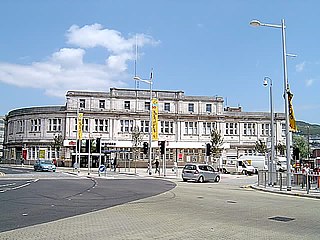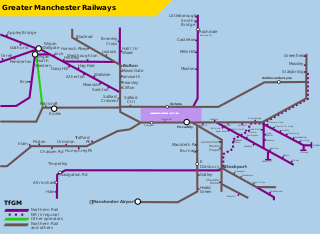
The railway system in Great Britain is the oldest railway system in the world. The first locomotive-hauled public railway opened in 1825, which was followed by an era of rapid expansion. Most of the track is managed by Network Rail, which in 2017 had a network of 9,824 miles (15,811 km) of standard-gauge lines, of which 3,339 miles (5,374 km) were electrified. In addition, some cities have separate metro, light rail and tram systems, among them the historic London Underground and the Glasgow Subway. There are also many private railways, some of them narrow-gauge, which are primarily short lines for tourists. The main rail network is connected with that of continental Europe by the Channel Tunnel and High Speed 1, opened in 1994 and 2007 respectively.
British Railways (BR), which from 1965 traded as British Rail, was a state-owned company that operated most rail transport in Great Britain from 1948 to 1997. Originally a trading brand of the Railway Executive of the British Transport Commission, it became an independent statutory corporation in January 1963, when it was formally renamed the British Railways Board.
National Rail (NR) is the trading name licensed for use by the Rail Delivery Group, an unincorporated association whose membership consists of the passenger train operating companies (TOCs) of England, Scotland, and Wales. The TOCs run the passenger services previously provided by the British Railways Board, from 1965 using the brand name British Rail. Northern Ireland, which is bordered by the Republic of Ireland, has a different system. National Rail services share a ticketing structure and inter-availability that generally do not extend to services which were not part of British Rail.

Transport in the United Kingdom is highly facilitated by road, rail, air and water networks. Transport is a devolved matter with each of the countries of the United Kingdom having separate systems under separate governments. A radial road network totals 29,145 miles (46,904 km) of main roads, 2,173 miles (3,497 km) of motorways and 213,750 miles (344,000 km) of paved roads.

Network Rail Limited is the owner and infrastructure manager of most of the railway network in Great Britain. Network Rail is a non-departmental public body of the Department for Transport with no shareholders, which reinvests its income in the railways.
The Rail Delivery Group Limited (RDG), previously the Association of Train Operating Companies, is the British rail industry membership body that brings together passenger and freight rail companies, Network Rail and High Speed 2. The RDG is approximately half-funded by Network Rail, the remainder of its funding being provided by the various transport groups it represents.

The railway system of Great Britain started with the building of local isolated wooden wagonways starting in the 1560s. A patchwork of local rail links operated by small private railway companies developed in the late 18th century. These isolated links expanded during the railway boom of the 1840s into a national network, although initially being run by over one hundred competing companies. Over the course of the 19th and early 20th centuries, many of these were amalgamated or were bought by competitors until only a handful of larger companies remained. The period also saw a steady increase in government involvement, especially in safety matters, such as the Railway Inspectorate.

Cardiff Central is a major station on the South Wales Main Line. It is located in the capital of Wales, Cardiff, 144 miles 77 chains (233 km) down the line from London Paddington, via Bristol Parkway, and 170 miles 30 chains (274 km) measured via Stroud. It is one of the city's two urban rail network hubs, along with Cardiff Queen Street. Opened in 1850 as Cardiff station, it was renamed Cardiff General in 1924 and then Cardiff Central in 1973.
The privatisation of British Rail was the process by which ownership and operation of the railways of Great Britain passed from government control into private hands. Begun in 1994, the process was largely completed by 1997. The deregulation of the industry was in part motivated by the enactment of EU Directive 91/440 in 1991, which aimed to create a more efficient railway network by creating greater competition.

Bus deregulation in Great Britain involved the abolition of Road Service Licensing for bus services outside of Greater London. It began in 1980 with long-distance bus services and was extended to local bus services in 1986 under the Transport Act 1985. The abolition of Road Service Licensing removed the public sector's role in fare-setting, routes, and bus frequencies and returned those powers to bus operators.

Swansea railway station serves the city of Swansea, Wales. It is 216 miles 7 chains (348 km) measured from London Paddington on the National Rail network.

Transport in Sydney is provided by an extensive network of public transport operating modes including metro, train, bus, ferry and light rail, as well as an expansive network of roadways, cycleways and airports. According to the 2006 census, in terms of travel to work or study Sydney has the highest rate of public transport usage among the Australian capital cities of 26.3% with more than 80% of weekday trips to/from Central Sydney being made by public transport. According to the New South Wales State Plan, the state has Australia's largest public transport system. The public transport network is regulated by Transport for NSW.
In addition to the large number and variety of short-term or localised promotional fares that have been available to passengers on the British railway network in recent decades, there are many permanent concessionary fare schemes available to passengers. Some of these take the form of Railcards, which can be purchased by people who qualify according to the conditions, and which give discounts for all journeys over a period; other concessions are available for individual journeys. In all cases, details of the type of concession will be printed on the passenger's travel ticket, to distinguish reduced-rate tickets from those sold at the standard full fare.

The period from 1995 covers the history of rail transport in Great Britain following the privatisation of British Rail. During this period, passenger volumes have grown rapidly, safety has improved, and subsidies per journey have fallen. However, there is debate as to whether this is due to privatisation or to better government regulation. During this period, High Speed 1, the West Coast Main Line upgrade and Crossrail were completed and more construction projects are currently under way. The period also saw the demise of privately-owned Railtrack and its replacement with government-owned Network Rail.
Fare avoidance, as distinct from fare evasion, is the lawful use of knowledge to travel using tickets which cost significantly less than the 'normal' fare for a given journey, which is what one might be expected to use. It is common in some parts of the world with complex travel networks, notably the National Rail network of Great Britain.

Passenger rail franchising in Great Britain is the system of contracting the operation of the passenger services on the railways of Great Britain to private companies, which has been in effect since 1996 and was greatly altered in 2020, with rail franchising being effectively abolished in May 2021.
A penalty fare, standard fare, or fixed penalty notice is a special, usually higher, fare charged because a passenger using public transport did not comply with the normal ticket purchasing rules. It should not be confused with an unpaid fares notice.

The Manchester station group is a station group of four railway stations in Manchester city centre, England; this consists of Manchester Piccadilly, Manchester Oxford Road, Manchester Victoria and Deansgate. The station group is printed on national railway tickets as MANCHESTER STNS. For passengers travelling from one of the 91 National Rail stations in Greater Manchester, the four stations are printed as MANCHESTER CTLZ which additionally permits the use of Metrolink tram services in Zone 1.

The impact of the privatisation of British Rail has been the subject of much debate, with the stated benefits including improved customer service, and more investment; and stated drawbacks including higher fares, lower punctuality and increased rail subsidies. The privatisation of British Rail began in the 1990s.
Many countries offer subsidies to their railways because of the social and economic benefits that it brings. The economic benefits can greatly assist in funding the rail network. Those countries usually also fund or subsidize road construction, and therefore effectively also subsidize road transport. Rail subsidies vary in both size and how they are distributed, with some countries funding the infrastructure and others funding trains and their operators, while others have a mixture of both. Subsidies can be used for either investment in upgrades and new lines, or to keep lines running that create economic growth.










